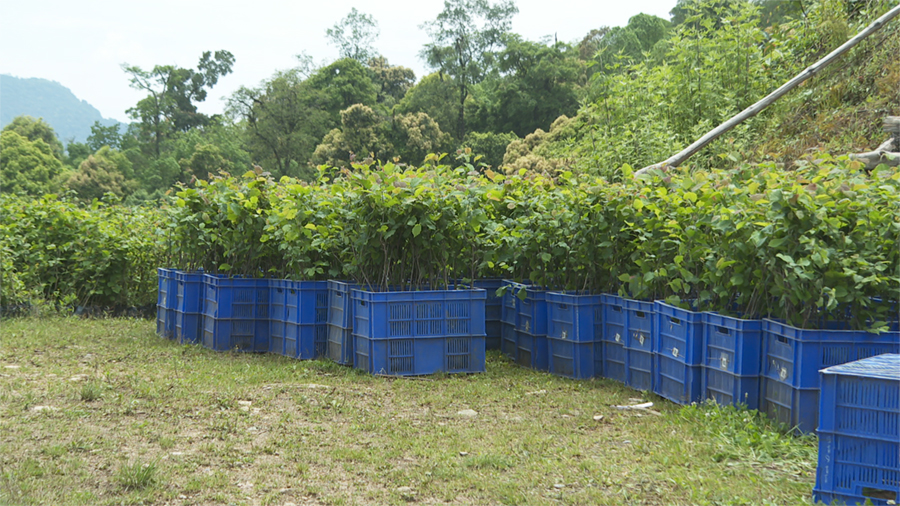
Hazelnut growers in some districts have faced challenges in maintaining chill hours during winter months. This has led to reduced yields and in some cases, no fruiting at all. A chill hour is the amount of cold hours a tree needs in winter for flowering and fruit production. However, the Mountain Hazelnuts Venture has been piloting climate grafting to address this issue by adapting hazelnut trees to the changing climate conditions. In this story, we will look at successful hazelnut ventures and growers’ anticipation of the nationwide grafting programme that aims to speed up nut production.
Choney Wangmo from Yagpogang in Monggar began growing hazelnuts when Mountain Hazelnuts Venture first distributed the saplings.
The 54-year-old works alone on her nearly three-acre orchard without any assistance. Choney uses her nephew’s previously barren land to plant hazelnut trees.
Today, hazelnuts are her primary source of income. She says it has greatly benefited her.
“The company provided us with saplings and we worked hard. Through hard work, I have been able to increase my hazelnut production and income. This has benefitted both me and the company. If the company had not provided us with hazelnut seedlings, the land would have remained barren.”
She added that she initially fetched only about Nu 33 a kilogramme of hazelnuts. Now, she earns Nu 100 a kilogramme.
Mountain Hazelnuts Venture’s Operations Head for Lhuentse, Monggar, Trashi Yangtse, and upper Trashigang, Pema Lodey said that Choney’s orchard is thriving because of the equal distribution of both male and female varieties.
“In this orchard, we distributed the initial batch of saplings at the beginning of the venture. Although it is the first batch of saplings, all trees are fruiting well, achieving 100 per cent nut yield. This success is due to the presence of both female and male varieties of trees in the orchard. Meanwhile, some orchards are not fruiting well because they lack both male and female varieties.”
The company began grafting in seven districts in 2022. This year, they expanded to a nationwide climate grafting programme across 18 districts to replace non-productive hazelnut varieties with ones better suited to Bhutan’s climate.
The venture has also trained field officers in all 18 districts.
Another grower, Tenzin Wangmo from Monggar said that after the grafting programme, the quality of nuts has improved, and trees that previously did not bear fruit have started fruiting.
“After the successful grafting programme, people look at our orchard as an example. After that, other orchards were also grafted. As of now, the trees are flowering and fruiting well. It started fruiting nuts after a year of grafting.”
Similarly, a farmers’ cooperative at Khalong Chiwog in Monggar is reaping benefits from its 20-acre orchard. However, they have not participated in the grafting programme yet.
Members said they are awaiting results from other grafted orchards before starting the process with their trees.
“We are hoping that it benefits the community. And we are brimmed with joy with the growth of the trees. The quantity of nuts is increasing annually. So, we are happy,” said Nidup Gyeltshen, a member of the cooperative.
Meanwhile, according to the Mountain Hazelnuts Venture, the aftercare for grafted plants is crucial. As the grafted stem grows, the plastic wrap around it should be loosened. When the stem reaches almost a metre in height, it should be supported to protect it against wind and animals.
“It has been two years since we started the grafting programme. Therefore, those trees grafted in 2022 are fruiting nuts. Hereafter, growers need to take care of the grafted plants. The company provides strategies for fruiting but it is the growers’ responsibility to take care of the grafted trees and let them fruit well,” said Kinley Tshering, advocacy officer at Mountain Hazelnuts Venture.
The Mountain Hazelnuts Venture said that they are continuing to distribute saplings to growers who come forward to register.
Today, most of the growers sell their produce to the venture. The company has exported over 8,000 kilogrammes of hazelnuts to Australia in the past two years.
Devika Pradhan
Edited by Sonam Pem








